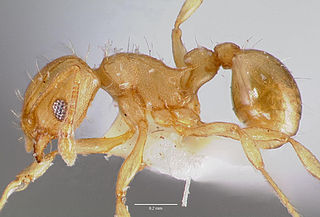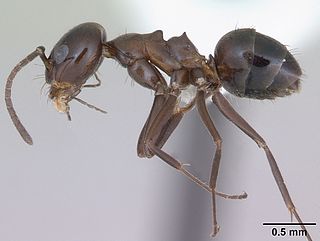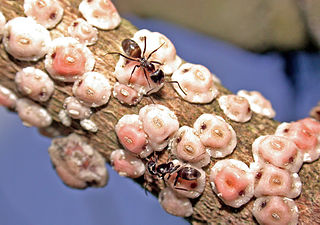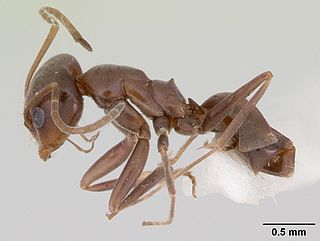
Tineidae is a family of moths in the order Lepidoptera described by Pierre André Latreille in 1810. Collectively, they are known as fungus moths or tineid moths. The family contains considerably more than 3,000 species in more than 300 genera. Most of the tineid moths are small or medium-sized, with wings held roofwise over the body when at rest. They are particularly common in the Palaearctic, but many occur elsewhere, and some are found very widely as introduced species.

Wasmannia is a genus of ants. Wasmannia auropunctata is known as the electric ant or little fire ant and are considered by many countries to be a destructive, highly invasive species.

Dorymyrmex insanus is a species of pyramid ant, one of several species known as crazy ants, for their "frenetic" movement and swarming behavior. It is found in hot, dry habitats in the southern parts of the United States, much of Central America, and tropical South America. Dorymyrmex insanus is listed as Vulnerable by the International Union for Conservation of Nature (IUCN).

Kalathomyrmex is a genus of ant in the subfamily Myrmicinae containing the single species Kalathomyrmex emeryi. First described as Myrmicocrypta emeryi by Forel in 1907, the species was most recently moved to its current genus by Klingenberg and Brandao in 2009.

Prehistoric Lepidoptera are both butterflies and moths that lived before recorded history. The fossil record for Lepidoptera is lacking in comparison to other winged species, and tending not to be as common as some other insects in the habitats that are most conducive to fossilization, such as lakes and ponds, and their juvenile stage has only the head capsule as a hard part that might be preserved. The location and abundance of the most common moth species are indicative that mass migrations of moths occurred over the Palaeogene North Sea, which is why there is a serious lack of moth fossils. Yet there are fossils, some preserved in amber and some in very fine sediments. Leaf mines are also seen in fossil leaves, although the interpretation of them is tricky. Putative fossil stem group representatives of Amphiesmenoptera are known from the Triassic.

Caliscelidae is a family of planthoppers, sap-sucking insects that belong to the order Hemiptera, suborder Auchenorrhyncha and superfamily Fulgoroidea. They are somewhat anomalous and have often been included within the family Issidae. Studies made in 2013 of the phylogeny of the Issidae and other groups using molecular techniques support the treatment of the group as a separate family. Sexual dimorphism can be marked. Some members of the family are called piglet bugs due to the shape of their snout. A particularly aberrant genus described in 2011 from India, Formiscurra, has males that resemble ants.

Dorymyrmex bicolor is a species of ant in the Dolichoderinae subfamily. Dorymyrmex bicolor was recently known as Conomyrma bicolor but has been renamed to Dorymyrmex bicolor. Dorymyrmex bicolor has a single petiole and a slit-like orifice which releases chemical compounds. This ant does not have the capability to sting. Dorymyrmex bicolor is primarily found in arid desert regions in Central and South America and the southwestern United States.

Dorymyrmex bituber is a species of ant in the genus Dorymyrmex. Described by Santschi in 1916, the species is endemic to Argentina and Paraguay.

Dorymyrmex brunneus is a species of ant in the genus Dorymyrmex. Described by Forel in 1908, the species is endemic to several nations in South America.
Dorymyrmex chilensis is a species of ant in the genus Dorymyrmex. Described by Forel in 1911, the species is endemic to Chile.

Dorymyrmex elegans is a species of ant in the genus Dorymyrmex. Described by Trager in 1988, the species is endemic to the United States and Mexico, where it is a nocturnal species and is normally seen on cool days.
Dorymyrmex emmaericaellus is a species of ant in the genus Dorymyrmex. Described by Kusnezov in 1951, the species is endemic to Bolivia.

Dorymyrmex goeldii is a species of ant in the genus Dorymyrmex. Described by Forel in 1904, the species is endemic to Brazil.

Dorymyrmex lipan is a species of ant in the genus Dorymyrmex. Described by Snelling in 1995, the species is endemic to the United States and Mexico.

Dorymyrmex paiute is a species of ant in the genus Dorymyrmex. Described by Snelling in 1995, the species is endemic to the United States.

Dorymyrmex paranensis is a species of ant in the genus Dorymyrmex. Described by Santschi in 1922, the species is endemic to Paraguay.

Dorymyrmex smithi is a species of ant in the genus Dorymyrmex. Described by Cole in 1936, the species is endemic to the United States and Mexico.

Dorymyrmex wheeleri is a species of ant in the genus Dorymyrmex. Described by Kusnezov in 1952, the species is endemic to the United States.
Dorymyrmex xerophylus is a species of ant in the genus Dorymyrmex. Described by Cuezzo and Guerrero in 2011, the species is endemic to Colombia.

















